Principles of Business Communication and Information Contents Report
VerifiedAdded on 2020/06/04
|14
|2842
|94
Report
AI Summary
This report, focusing on principles of business communication and information, explores key aspects of effective business practices. It begins by highlighting the importance of negotiation in the business environment, detailing various negotiation approaches and tactics. The report then delves into presentation methods, covering different types, resource utilization, delivery techniques, and feedback collection. Furthermore, it examines bespoke business documents, including their characteristics, creation factors, legal requirements, and approval processes. Finally, the report concludes with an analysis of information system development, outlining its stages, benefits, limitations, and security considerations.

Principles of Business
Communication and
Information
Communication and
Information
Paraphrase This Document
Need a fresh take? Get an instant paraphrase of this document with our AI Paraphraser
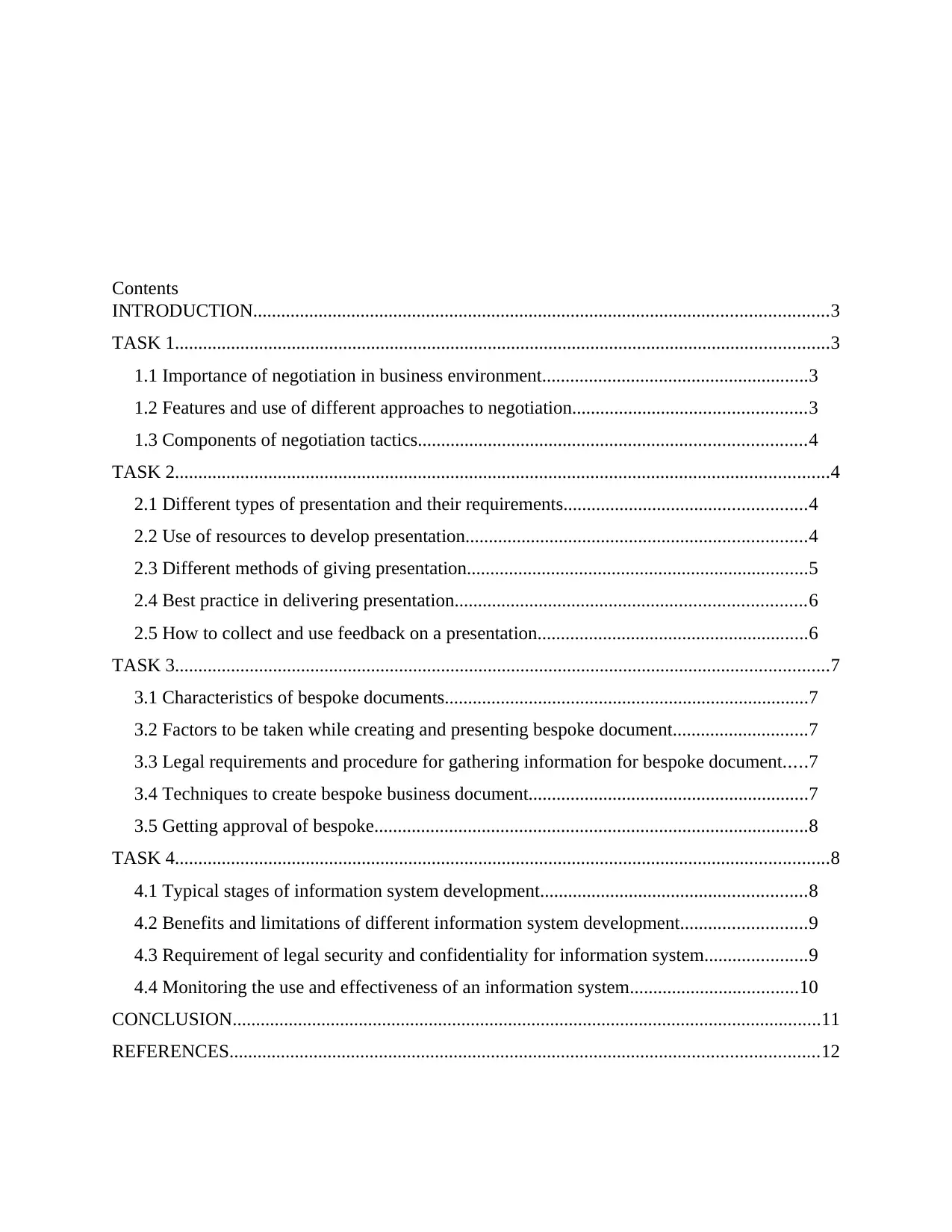
Contents
INTRODUCTION...........................................................................................................................3
TASK 1............................................................................................................................................3
1.1 Importance of negotiation in business environment.........................................................3
1.2 Features and use of different approaches to negotiation..................................................3
1.3 Components of negotiation tactics...................................................................................4
TASK 2............................................................................................................................................4
2.1 Different types of presentation and their requirements....................................................4
2.2 Use of resources to develop presentation.........................................................................4
2.3 Different methods of giving presentation.........................................................................5
2.4 Best practice in delivering presentation...........................................................................6
2.5 How to collect and use feedback on a presentation..........................................................6
TASK 3............................................................................................................................................7
3.1 Characteristics of bespoke documents..............................................................................7
3.2 Factors to be taken while creating and presenting bespoke document.............................7
3.3 Legal requirements and procedure for gathering information for bespoke document.....7
3.4 Techniques to create bespoke business document............................................................7
3.5 Getting approval of bespoke.............................................................................................8
TASK 4............................................................................................................................................8
4.1 Typical stages of information system development.........................................................8
4.2 Benefits and limitations of different information system development...........................9
4.3 Requirement of legal security and confidentiality for information system......................9
4.4 Monitoring the use and effectiveness of an information system....................................10
CONCLUSION..............................................................................................................................11
REFERENCES..............................................................................................................................12
INTRODUCTION...........................................................................................................................3
TASK 1............................................................................................................................................3
1.1 Importance of negotiation in business environment.........................................................3
1.2 Features and use of different approaches to negotiation..................................................3
1.3 Components of negotiation tactics...................................................................................4
TASK 2............................................................................................................................................4
2.1 Different types of presentation and their requirements....................................................4
2.2 Use of resources to develop presentation.........................................................................4
2.3 Different methods of giving presentation.........................................................................5
2.4 Best practice in delivering presentation...........................................................................6
2.5 How to collect and use feedback on a presentation..........................................................6
TASK 3............................................................................................................................................7
3.1 Characteristics of bespoke documents..............................................................................7
3.2 Factors to be taken while creating and presenting bespoke document.............................7
3.3 Legal requirements and procedure for gathering information for bespoke document.....7
3.4 Techniques to create bespoke business document............................................................7
3.5 Getting approval of bespoke.............................................................................................8
TASK 4............................................................................................................................................8
4.1 Typical stages of information system development.........................................................8
4.2 Benefits and limitations of different information system development...........................9
4.3 Requirement of legal security and confidentiality for information system......................9
4.4 Monitoring the use and effectiveness of an information system....................................10
CONCLUSION..............................................................................................................................11
REFERENCES..............................................................................................................................12
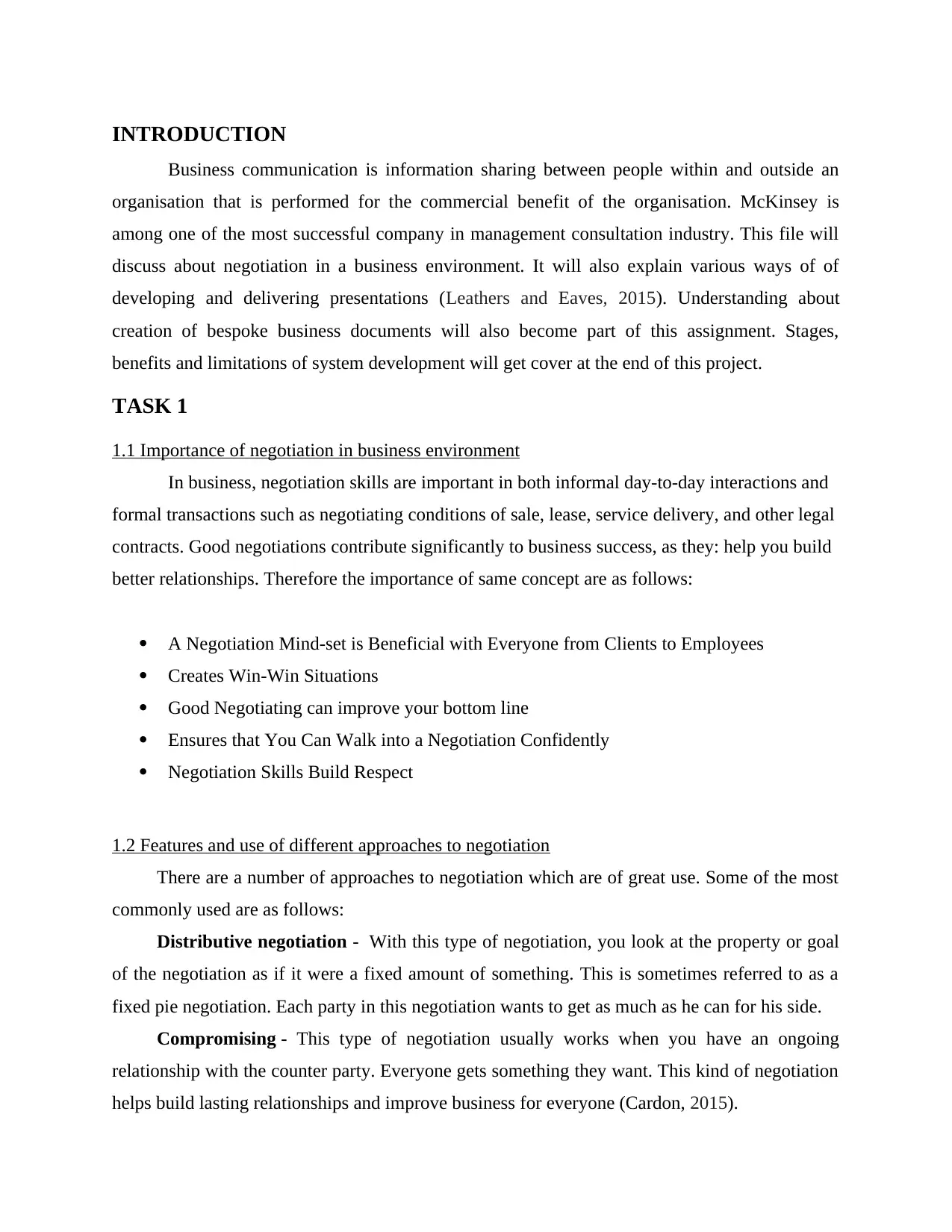
INTRODUCTION
Business communication is information sharing between people within and outside an
organisation that is performed for the commercial benefit of the organisation. McKinsey is
among one of the most successful company in management consultation industry. This file will
discuss about negotiation in a business environment. It will also explain various ways of of
developing and delivering presentations (Leathers and Eaves, 2015). Understanding about
creation of bespoke business documents will also become part of this assignment. Stages,
benefits and limitations of system development will get cover at the end of this project.
TASK 1
1.1 Importance of negotiation in business environment
In business, negotiation skills are important in both informal day-to-day interactions and
formal transactions such as negotiating conditions of sale, lease, service delivery, and other legal
contracts. Good negotiations contribute significantly to business success, as they: help you build
better relationships. Therefore the importance of same concept are as follows:
A Negotiation Mind-set is Beneficial with Everyone from Clients to Employees
Creates Win-Win Situations
Good Negotiating can improve your bottom line
Ensures that You Can Walk into a Negotiation Confidently
Negotiation Skills Build Respect
1.2 Features and use of different approaches to negotiation
There are a number of approaches to negotiation which are of great use. Some of the most
commonly used are as follows:
Distributive negotiation - With this type of negotiation, you look at the property or goal
of the negotiation as if it were a fixed amount of something. This is sometimes referred to as a
fixed pie negotiation. Each party in this negotiation wants to get as much as he can for his side.
Compromising - This type of negotiation usually works when you have an ongoing
relationship with the counter party. Everyone gets something they want. This kind of negotiation
helps build lasting relationships and improve business for everyone (Cardon, 2015).
Business communication is information sharing between people within and outside an
organisation that is performed for the commercial benefit of the organisation. McKinsey is
among one of the most successful company in management consultation industry. This file will
discuss about negotiation in a business environment. It will also explain various ways of of
developing and delivering presentations (Leathers and Eaves, 2015). Understanding about
creation of bespoke business documents will also become part of this assignment. Stages,
benefits and limitations of system development will get cover at the end of this project.
TASK 1
1.1 Importance of negotiation in business environment
In business, negotiation skills are important in both informal day-to-day interactions and
formal transactions such as negotiating conditions of sale, lease, service delivery, and other legal
contracts. Good negotiations contribute significantly to business success, as they: help you build
better relationships. Therefore the importance of same concept are as follows:
A Negotiation Mind-set is Beneficial with Everyone from Clients to Employees
Creates Win-Win Situations
Good Negotiating can improve your bottom line
Ensures that You Can Walk into a Negotiation Confidently
Negotiation Skills Build Respect
1.2 Features and use of different approaches to negotiation
There are a number of approaches to negotiation which are of great use. Some of the most
commonly used are as follows:
Distributive negotiation - With this type of negotiation, you look at the property or goal
of the negotiation as if it were a fixed amount of something. This is sometimes referred to as a
fixed pie negotiation. Each party in this negotiation wants to get as much as he can for his side.
Compromising - This type of negotiation usually works when you have an ongoing
relationship with the counter party. Everyone gets something they want. This kind of negotiation
helps build lasting relationships and improve business for everyone (Cardon, 2015).
⊘ This is a preview!⊘
Do you want full access?
Subscribe today to unlock all pages.

Trusted by 1+ million students worldwide
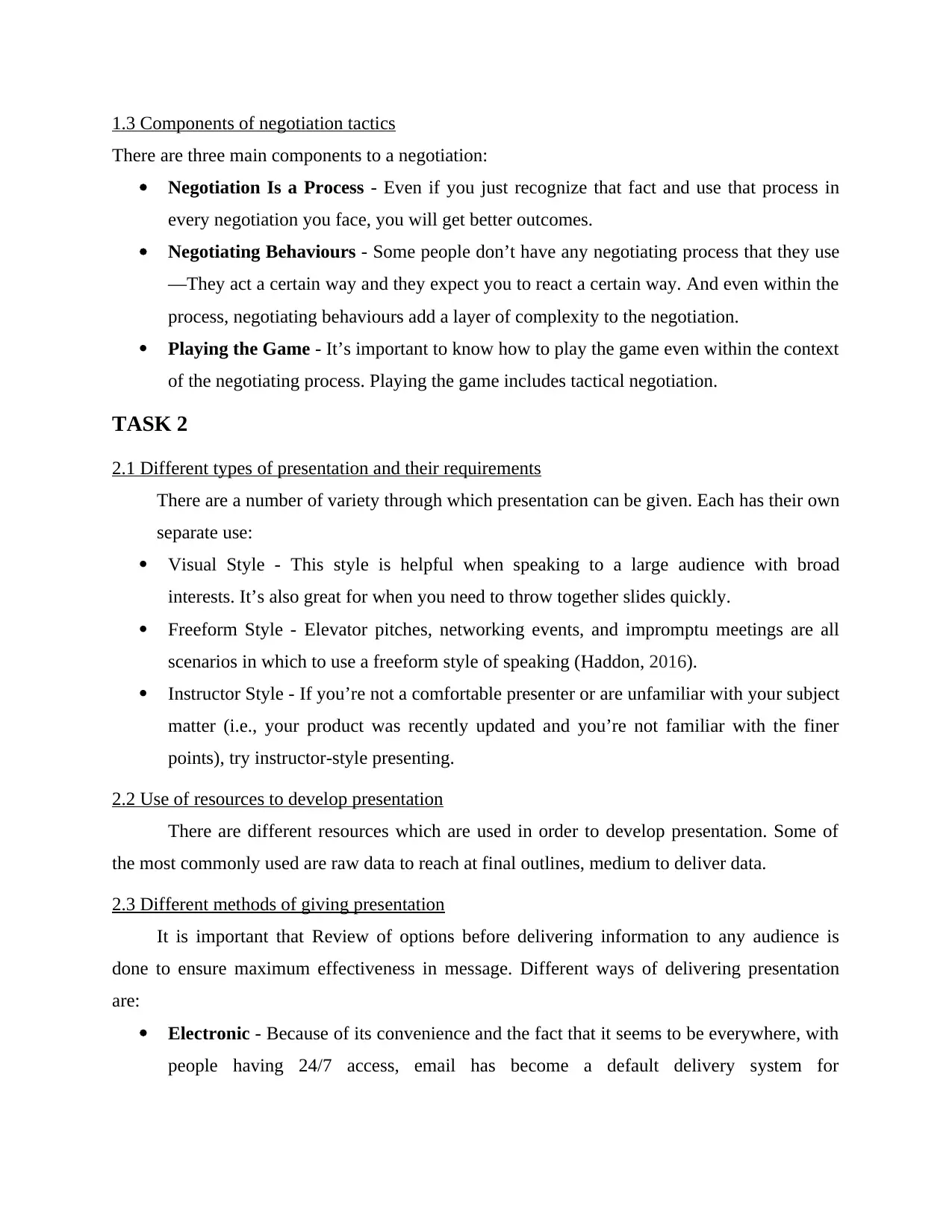
1.3 Components of negotiation tactics
There are three main components to a negotiation:
Negotiation Is a Process - Even if you just recognize that fact and use that process in
every negotiation you face, you will get better outcomes.
Negotiating Behaviours - Some people don’t have any negotiating process that they use
—They act a certain way and they expect you to react a certain way. And even within the
process, negotiating behaviours add a layer of complexity to the negotiation.
Playing the Game - It’s important to know how to play the game even within the context
of the negotiating process. Playing the game includes tactical negotiation.
TASK 2
2.1 Different types of presentation and their requirements
There are a number of variety through which presentation can be given. Each has their own
separate use:
Visual Style - This style is helpful when speaking to a large audience with broad
interests. It’s also great for when you need to throw together slides quickly.
Freeform Style - Elevator pitches, networking events, and impromptu meetings are all
scenarios in which to use a freeform style of speaking (Haddon, 2016).
Instructor Style - If you’re not a comfortable presenter or are unfamiliar with your subject
matter (i.e., your product was recently updated and you’re not familiar with the finer
points), try instructor-style presenting.
2.2 Use of resources to develop presentation
There are different resources which are used in order to develop presentation. Some of
the most commonly used are raw data to reach at final outlines, medium to deliver data.
2.3 Different methods of giving presentation
It is important that Review of options before delivering information to any audience is
done to ensure maximum effectiveness in message. Different ways of delivering presentation
are:
Electronic - Because of its convenience and the fact that it seems to be everywhere, with
people having 24/7 access, email has become a default delivery system for
There are three main components to a negotiation:
Negotiation Is a Process - Even if you just recognize that fact and use that process in
every negotiation you face, you will get better outcomes.
Negotiating Behaviours - Some people don’t have any negotiating process that they use
—They act a certain way and they expect you to react a certain way. And even within the
process, negotiating behaviours add a layer of complexity to the negotiation.
Playing the Game - It’s important to know how to play the game even within the context
of the negotiating process. Playing the game includes tactical negotiation.
TASK 2
2.1 Different types of presentation and their requirements
There are a number of variety through which presentation can be given. Each has their own
separate use:
Visual Style - This style is helpful when speaking to a large audience with broad
interests. It’s also great for when you need to throw together slides quickly.
Freeform Style - Elevator pitches, networking events, and impromptu meetings are all
scenarios in which to use a freeform style of speaking (Haddon, 2016).
Instructor Style - If you’re not a comfortable presenter or are unfamiliar with your subject
matter (i.e., your product was recently updated and you’re not familiar with the finer
points), try instructor-style presenting.
2.2 Use of resources to develop presentation
There are different resources which are used in order to develop presentation. Some of
the most commonly used are raw data to reach at final outlines, medium to deliver data.
2.3 Different methods of giving presentation
It is important that Review of options before delivering information to any audience is
done to ensure maximum effectiveness in message. Different ways of delivering presentation
are:
Electronic - Because of its convenience and the fact that it seems to be everywhere, with
people having 24/7 access, email has become a default delivery system for
Paraphrase This Document
Need a fresh take? Get an instant paraphrase of this document with our AI Paraphraser

information. Other ways to send messages electronically include social media, website
banners and pay-per-click ads.
Print - Print media have an advantage over electronic communication in that you won’t
have to worry about how the message looks on devices and computers with different
display settings (Cummings and O’Neil, 2015).
Visual Aids - Standing in front of a group and speaking for long periods while holding
notes in your hand can become monotonous. Using visual aids will better engage
attendees and make your points.
Face-to-Face - If the majority of your sales efforts are done via email or over the phone,
review potential customers you haven’t been able to crack and evaluate whether the cost
of an in-person meeting might be worth the potential sales. Face-to-face meetings let you
get more personal, evaluate the body language of your peers, demonstrate products and
use visual aids. Similarly, as you’re getting ready to circulate yet another employee
memo or blast email, consider whether you’d make a bigger impact if you called
everyone together in a meeting to make the announcement. The questions and feedback
you receive instantly go the to whole group (van Ginkel, and et.al., 2015).
Teleconference - If you can’t afford to get everyone in the same room, consider
teleconferencing. These meetings give you many of the same benefits of face-to-face
communications without the travel costs and scheduling headaches. You can schedule
these meetings on short notice, and even technophobes can learn how to use basic video
technology that often comes free with a smartphone or personal compute
2.4 Best practice in delivering presentation
Conversely, conscious delivery can enhance an audience’s understanding and increase
the likelihood that they’ll be influenced by your message. Here are three delivery techniques to
try:
Drag - This is the name for a technique taught to us by Colorado Springs-based
speaker/story-teller, Doug Stevenson. Drag out your words to emphasise an assertion or
point. In the drag each word is separated from the others and given equal weight. So the
sentence takes longer to say and its delivery is quite deliberate and measured. This lets
the audience know that this statement is more important than those around it.
banners and pay-per-click ads.
Print - Print media have an advantage over electronic communication in that you won’t
have to worry about how the message looks on devices and computers with different
display settings (Cummings and O’Neil, 2015).
Visual Aids - Standing in front of a group and speaking for long periods while holding
notes in your hand can become monotonous. Using visual aids will better engage
attendees and make your points.
Face-to-Face - If the majority of your sales efforts are done via email or over the phone,
review potential customers you haven’t been able to crack and evaluate whether the cost
of an in-person meeting might be worth the potential sales. Face-to-face meetings let you
get more personal, evaluate the body language of your peers, demonstrate products and
use visual aids. Similarly, as you’re getting ready to circulate yet another employee
memo or blast email, consider whether you’d make a bigger impact if you called
everyone together in a meeting to make the announcement. The questions and feedback
you receive instantly go the to whole group (van Ginkel, and et.al., 2015).
Teleconference - If you can’t afford to get everyone in the same room, consider
teleconferencing. These meetings give you many of the same benefits of face-to-face
communications without the travel costs and scheduling headaches. You can schedule
these meetings on short notice, and even technophobes can learn how to use basic video
technology that often comes free with a smartphone or personal compute
2.4 Best practice in delivering presentation
Conversely, conscious delivery can enhance an audience’s understanding and increase
the likelihood that they’ll be influenced by your message. Here are three delivery techniques to
try:
Drag - This is the name for a technique taught to us by Colorado Springs-based
speaker/story-teller, Doug Stevenson. Drag out your words to emphasise an assertion or
point. In the drag each word is separated from the others and given equal weight. So the
sentence takes longer to say and its delivery is quite deliberate and measured. This lets
the audience know that this statement is more important than those around it.
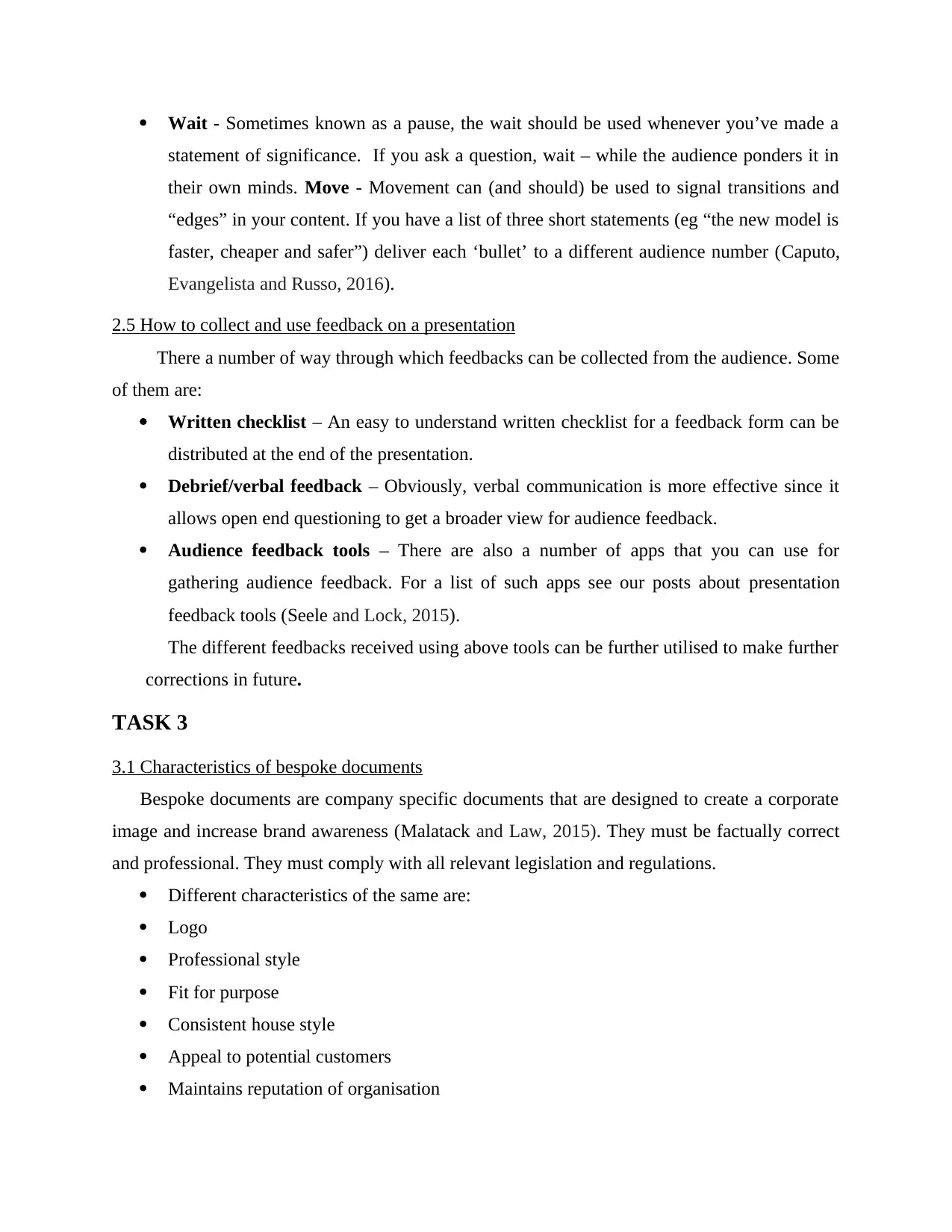
Wait - Sometimes known as a pause, the wait should be used whenever you’ve made a
statement of significance. If you ask a question, wait – while the audience ponders it in
their own minds. Move - Movement can (and should) be used to signal transitions and
“edges” in your content. If you have a list of three short statements (eg “the new model is
faster, cheaper and safer”) deliver each ‘bullet’ to a different audience number (Caputo,
Evangelista and Russo, 2016).
2.5 How to collect and use feedback on a presentation
There a number of way through which feedbacks can be collected from the audience. Some
of them are:
Written checklist – An easy to understand written checklist for a feedback form can be
distributed at the end of the presentation.
Debrief/verbal feedback – Obviously, verbal communication is more effective since it
allows open end questioning to get a broader view for audience feedback.
Audience feedback tools – There are also a number of apps that you can use for
gathering audience feedback. For a list of such apps see our posts about presentation
feedback tools (Seele and Lock, 2015).
The different feedbacks received using above tools can be further utilised to make further
corrections in future.
TASK 3
3.1 Characteristics of bespoke documents
Bespoke documents are company specific documents that are designed to create a corporate
image and increase brand awareness (Malatack and Law, 2015). They must be factually correct
and professional. They must comply with all relevant legislation and regulations.
Different characteristics of the same are:
Logo
Professional style
Fit for purpose
Consistent house style
Appeal to potential customers
Maintains reputation of organisation
statement of significance. If you ask a question, wait – while the audience ponders it in
their own minds. Move - Movement can (and should) be used to signal transitions and
“edges” in your content. If you have a list of three short statements (eg “the new model is
faster, cheaper and safer”) deliver each ‘bullet’ to a different audience number (Caputo,
Evangelista and Russo, 2016).
2.5 How to collect and use feedback on a presentation
There a number of way through which feedbacks can be collected from the audience. Some
of them are:
Written checklist – An easy to understand written checklist for a feedback form can be
distributed at the end of the presentation.
Debrief/verbal feedback – Obviously, verbal communication is more effective since it
allows open end questioning to get a broader view for audience feedback.
Audience feedback tools – There are also a number of apps that you can use for
gathering audience feedback. For a list of such apps see our posts about presentation
feedback tools (Seele and Lock, 2015).
The different feedbacks received using above tools can be further utilised to make further
corrections in future.
TASK 3
3.1 Characteristics of bespoke documents
Bespoke documents are company specific documents that are designed to create a corporate
image and increase brand awareness (Malatack and Law, 2015). They must be factually correct
and professional. They must comply with all relevant legislation and regulations.
Different characteristics of the same are:
Logo
Professional style
Fit for purpose
Consistent house style
Appeal to potential customers
Maintains reputation of organisation
⊘ This is a preview!⊘
Do you want full access?
Subscribe today to unlock all pages.

Trusted by 1+ million students worldwide

3.2 Factors to be taken while creating and presenting bespoke document
When you are designing the documents, make sure that you know what the purpose of the
document is and consider the following questions:
Who is the audience for my document?
What style, content and format should I use?
Does the document incorporate the organisation’s corporate aims/mission?
Will the document achieve what I want it to do?
3.3 Legal requirements and procedure for gathering information for bespoke document
There are different sources from where data regarding bespoke document can be
collected and used. Some of them are given below:
Data Protection Act 1998
Copyright, Designs and Patents Act 1988
Remit and limits of research
Recording sources
3.4 Techniques to create bespoke business document
In order to create a bespoke business document, the following procedure can be followed:
A brief of the document – what are the requirements
Research carried out – sources of information. Planning research, conducting research,
recording research
Providing design options – knowledge and supplication of legislation, effective use of
software, appropriate document type. Document size and style, accurate data input, image
size and quality
Approval of document – checking and proofreading, editing skills. Consultation,
feedback, approval (Krombholz, and et.al., 2015).
3.5 Getting approval of bespoke
In order to get approval of bespoke person there are different ways are present like:
Methods
Face-to-face meetings
On-line meetings
When you are designing the documents, make sure that you know what the purpose of the
document is and consider the following questions:
Who is the audience for my document?
What style, content and format should I use?
Does the document incorporate the organisation’s corporate aims/mission?
Will the document achieve what I want it to do?
3.3 Legal requirements and procedure for gathering information for bespoke document
There are different sources from where data regarding bespoke document can be
collected and used. Some of them are given below:
Data Protection Act 1998
Copyright, Designs and Patents Act 1988
Remit and limits of research
Recording sources
3.4 Techniques to create bespoke business document
In order to create a bespoke business document, the following procedure can be followed:
A brief of the document – what are the requirements
Research carried out – sources of information. Planning research, conducting research,
recording research
Providing design options – knowledge and supplication of legislation, effective use of
software, appropriate document type. Document size and style, accurate data input, image
size and quality
Approval of document – checking and proofreading, editing skills. Consultation,
feedback, approval (Krombholz, and et.al., 2015).
3.5 Getting approval of bespoke
In order to get approval of bespoke person there are different ways are present like:
Methods
Face-to-face meetings
On-line meetings
Paraphrase This Document
Need a fresh take? Get an instant paraphrase of this document with our AI Paraphraser

Conference calls
Use of technology – sharing documents, editing documents, tracking changes
Stages of approval
Initial proposal
Draft versions
Edited versions
Agreement of changes
Final approval.
TASK 4
4.1 Typical stages of information system development
An Information System (IS) is a system composed of people and computers that processes
or interprets information. The term is also sometimes used in more restricted senses to refer to
only the software used to run a computerised database or to refer to only a computer system.
Stages of information system development
Analysis – What data is going to be managed e.g. employee or customer records.
Feasibility study – what is the potential for success e.g. strengths and weaknesses,
resources needed.
Design – What are the detailed features and operations e.g. business rules.
Development – What is the specification e.g. are you meeting identified needs,
budget controls.
Testing – Is it fit for purpose e.g. is it reliable and accurate, does it se qualitative or
quantitative data, issues are recorded (Krombholz and et.al., 2015).
Deployment – Once the specification is accepted the following occurs e.g.
installation of the system.
Evaluation - Analysis of the testing is carried out e.g. looking at costs and benefits
against the original spec.
Maintenance – Monitoring the performance, problem solving.
4.2 Benefits and limitations of different information system development
The advantages and drawbacks of information system development is given in the table
below:
Use of technology – sharing documents, editing documents, tracking changes
Stages of approval
Initial proposal
Draft versions
Edited versions
Agreement of changes
Final approval.
TASK 4
4.1 Typical stages of information system development
An Information System (IS) is a system composed of people and computers that processes
or interprets information. The term is also sometimes used in more restricted senses to refer to
only the software used to run a computerised database or to refer to only a computer system.
Stages of information system development
Analysis – What data is going to be managed e.g. employee or customer records.
Feasibility study – what is the potential for success e.g. strengths and weaknesses,
resources needed.
Design – What are the detailed features and operations e.g. business rules.
Development – What is the specification e.g. are you meeting identified needs,
budget controls.
Testing – Is it fit for purpose e.g. is it reliable and accurate, does it se qualitative or
quantitative data, issues are recorded (Krombholz and et.al., 2015).
Deployment – Once the specification is accepted the following occurs e.g.
installation of the system.
Evaluation - Analysis of the testing is carried out e.g. looking at costs and benefits
against the original spec.
Maintenance – Monitoring the performance, problem solving.
4.2 Benefits and limitations of different information system development
The advantages and drawbacks of information system development is given in the table
below:

Benefits Limitation
Everyone has experience of manual systems
Relevance to user
Reduce information overload
Lower risk of data loss
Simplicity
Speed
Time
Efficiency
Physical space requirements
File naming conventions
Archiving requirements
Degradation of physical records
4.3 Requirement of legal security and confidentiality for information system
The requirements of legal security, transfer of information and confidentiality is of great
importance:
Legal requirements
Laws protecting public and private sector information – Data Protection, Freedom of
Information
Licensing arrangements
Accuracy of information
Security and confidentiality Requirements
Levels of access
Lockable security facilities
Security of keys
Use of policies and procedures to monitor systems
Use of passwords
Protection of computer systems
Transfer of information
Internal and external to the organisation
Codes of practice
Clear desk policy
Everyone has experience of manual systems
Relevance to user
Reduce information overload
Lower risk of data loss
Simplicity
Speed
Time
Efficiency
Physical space requirements
File naming conventions
Archiving requirements
Degradation of physical records
4.3 Requirement of legal security and confidentiality for information system
The requirements of legal security, transfer of information and confidentiality is of great
importance:
Legal requirements
Laws protecting public and private sector information – Data Protection, Freedom of
Information
Licensing arrangements
Accuracy of information
Security and confidentiality Requirements
Levels of access
Lockable security facilities
Security of keys
Use of policies and procedures to monitor systems
Use of passwords
Protection of computer systems
Transfer of information
Internal and external to the organisation
Codes of practice
Clear desk policy
⊘ This is a preview!⊘
Do you want full access?
Subscribe today to unlock all pages.

Trusted by 1+ million students worldwide

4.4 Monitoring the use and effectiveness of an information system
In order to monitor the use of effectiveness of an information following steps can be
followed (Cornelissen and Cornelissen, 2017).:
Have timescales for implementation and review
Obtain feedback from users e.g. ease of use, functionality
Timing of usage e.g. look at peak time usage for potential overload of system
Fit for purpose e.g. is it achieving the planned functionality
Gain early knowledge of faults
Have reporting systems in place
Identify user training requirements
CONCLUSION
At the end, it can be concluded that every there are various components of negotiation
technique. An organisation can adopt different types of presentation methods; they have various
requirements. Bespoke document has different characteristics. Information system has its own
benefits and limitations. Company should adopt one after evaluating their needs
In order to monitor the use of effectiveness of an information following steps can be
followed (Cornelissen and Cornelissen, 2017).:
Have timescales for implementation and review
Obtain feedback from users e.g. ease of use, functionality
Timing of usage e.g. look at peak time usage for potential overload of system
Fit for purpose e.g. is it achieving the planned functionality
Gain early knowledge of faults
Have reporting systems in place
Identify user training requirements
CONCLUSION
At the end, it can be concluded that every there are various components of negotiation
technique. An organisation can adopt different types of presentation methods; they have various
requirements. Bespoke document has different characteristics. Information system has its own
benefits and limitations. Company should adopt one after evaluating their needs
Paraphrase This Document
Need a fresh take? Get an instant paraphrase of this document with our AI Paraphraser
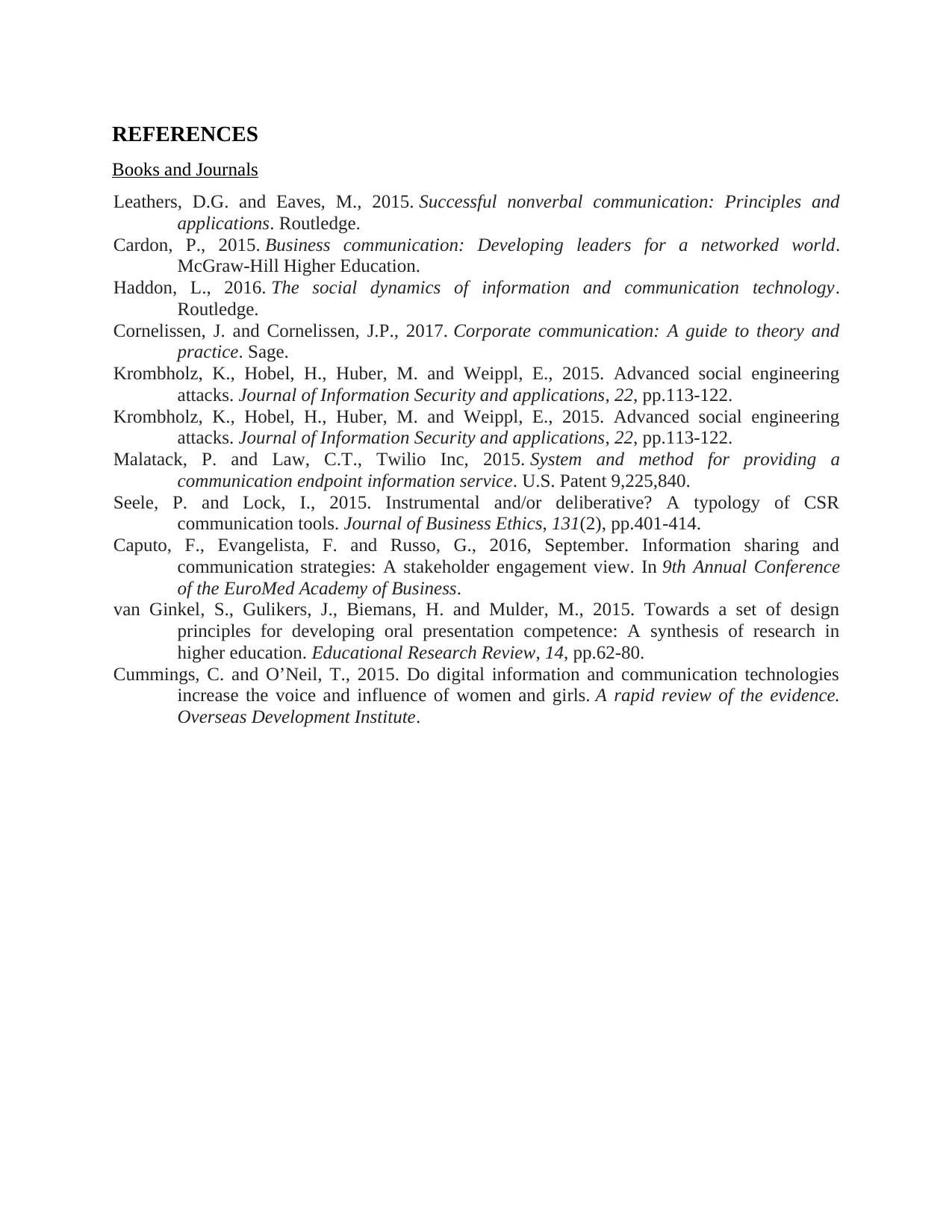
REFERENCES
Books and Journals
Leathers, D.G. and Eaves, M., 2015. Successful nonverbal communication: Principles and
applications. Routledge.
Cardon, P., 2015. Business communication: Developing leaders for a networked world.
McGraw-Hill Higher Education.
Haddon, L., 2016. The social dynamics of information and communication technology.
Routledge.
Cornelissen, J. and Cornelissen, J.P., 2017. Corporate communication: A guide to theory and
practice. Sage.
Krombholz, K., Hobel, H., Huber, M. and Weippl, E., 2015. Advanced social engineering
attacks. Journal of Information Security and applications, 22, pp.113-122.
Krombholz, K., Hobel, H., Huber, M. and Weippl, E., 2015. Advanced social engineering
attacks. Journal of Information Security and applications, 22, pp.113-122.
Malatack, P. and Law, C.T., Twilio Inc, 2015. System and method for providing a
communication endpoint information service. U.S. Patent 9,225,840.
Seele, P. and Lock, I., 2015. Instrumental and/or deliberative? A typology of CSR
communication tools. Journal of Business Ethics, 131(2), pp.401-414.
Caputo, F., Evangelista, F. and Russo, G., 2016, September. Information sharing and
communication strategies: A stakeholder engagement view. In 9th Annual Conference
of the EuroMed Academy of Business.
van Ginkel, S., Gulikers, J., Biemans, H. and Mulder, M., 2015. Towards a set of design
principles for developing oral presentation competence: A synthesis of research in
higher education. Educational Research Review, 14, pp.62-80.
Cummings, C. and O’Neil, T., 2015. Do digital information and communication technologies
increase the voice and influence of women and girls. A rapid review of the evidence.
Overseas Development Institute.
Books and Journals
Leathers, D.G. and Eaves, M., 2015. Successful nonverbal communication: Principles and
applications. Routledge.
Cardon, P., 2015. Business communication: Developing leaders for a networked world.
McGraw-Hill Higher Education.
Haddon, L., 2016. The social dynamics of information and communication technology.
Routledge.
Cornelissen, J. and Cornelissen, J.P., 2017. Corporate communication: A guide to theory and
practice. Sage.
Krombholz, K., Hobel, H., Huber, M. and Weippl, E., 2015. Advanced social engineering
attacks. Journal of Information Security and applications, 22, pp.113-122.
Krombholz, K., Hobel, H., Huber, M. and Weippl, E., 2015. Advanced social engineering
attacks. Journal of Information Security and applications, 22, pp.113-122.
Malatack, P. and Law, C.T., Twilio Inc, 2015. System and method for providing a
communication endpoint information service. U.S. Patent 9,225,840.
Seele, P. and Lock, I., 2015. Instrumental and/or deliberative? A typology of CSR
communication tools. Journal of Business Ethics, 131(2), pp.401-414.
Caputo, F., Evangelista, F. and Russo, G., 2016, September. Information sharing and
communication strategies: A stakeholder engagement view. In 9th Annual Conference
of the EuroMed Academy of Business.
van Ginkel, S., Gulikers, J., Biemans, H. and Mulder, M., 2015. Towards a set of design
principles for developing oral presentation competence: A synthesis of research in
higher education. Educational Research Review, 14, pp.62-80.
Cummings, C. and O’Neil, T., 2015. Do digital information and communication technologies
increase the voice and influence of women and girls. A rapid review of the evidence.
Overseas Development Institute.

1
⊘ This is a preview!⊘
Do you want full access?
Subscribe today to unlock all pages.

Trusted by 1+ million students worldwide
1 out of 14
Related Documents
Your All-in-One AI-Powered Toolkit for Academic Success.
+13062052269
info@desklib.com
Available 24*7 on WhatsApp / Email
![[object Object]](/_next/static/media/star-bottom.7253800d.svg)
Unlock your academic potential
Copyright © 2020–2025 A2Z Services. All Rights Reserved. Developed and managed by ZUCOL.





